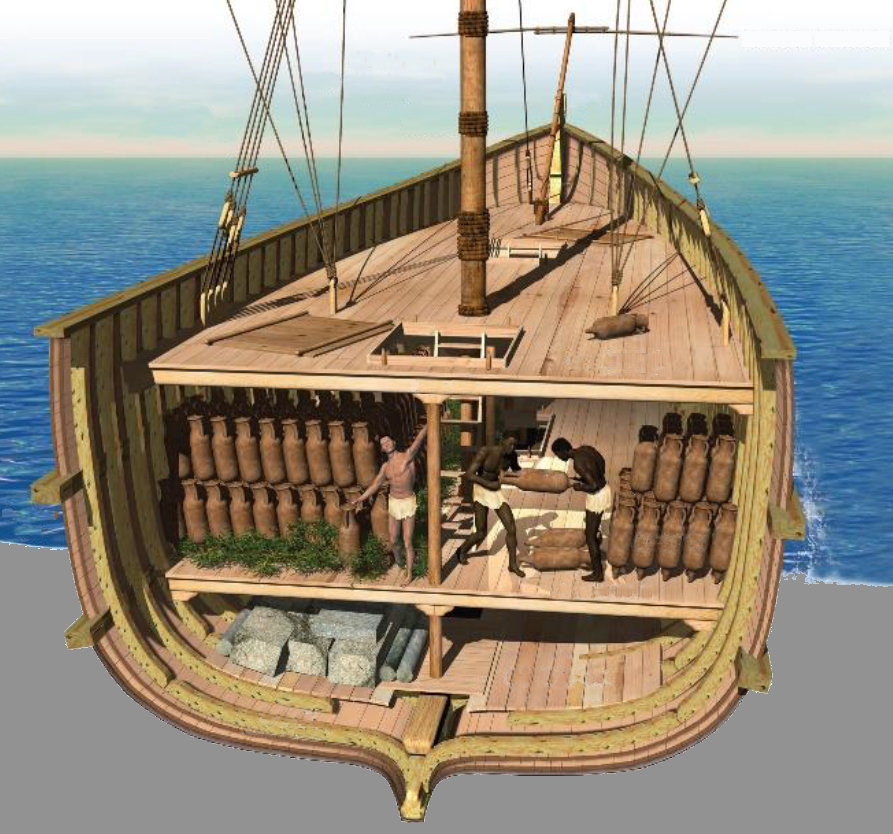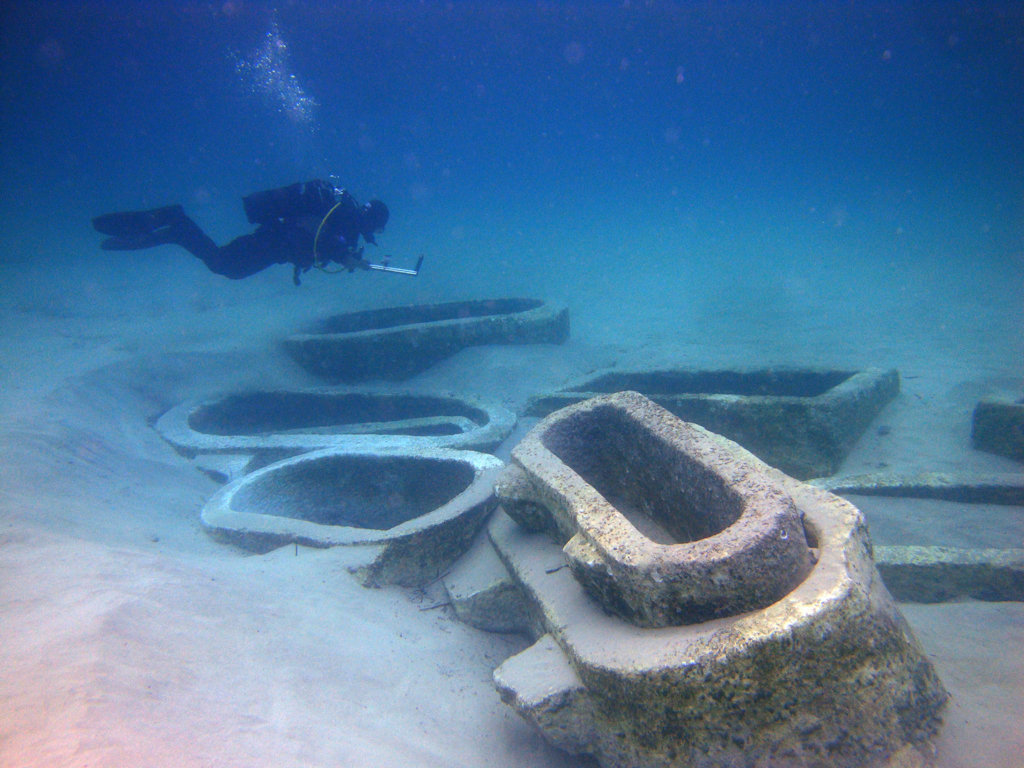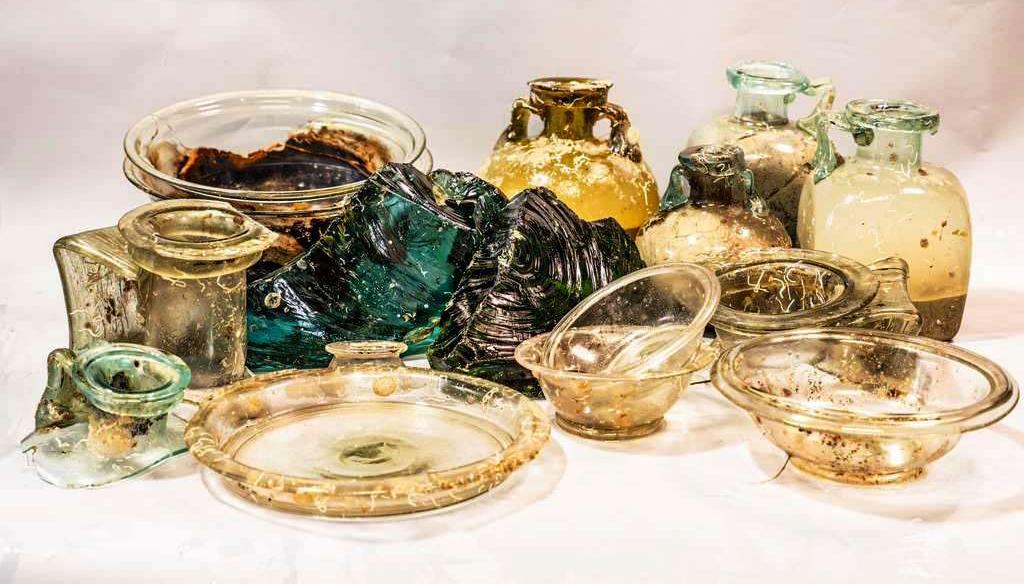Cargoes
Candace Rice, in an article published in 2016 (see the introduction), shed new light on an old question. Was trade on the Mediterranean Sea "primitive", was it a matter of ships hopping from harbour to harbour, looking for cargoes and trying to sell them in one of the next ports where the ship docked? Or was it more "advanced", was it a matter of contracts and loading cargoes that were stored in the warehouses of major ports? The former system is called tramping or, if we are to think of sailing close to the shore, cabotage. Rice tackles the issue by looking at the composition of the cargoes in shipwrecks, distinguishing cargoes consisting of a single commodity from a single region, multiple commodities from a single region, and multiple commodities from multiple regions. A distinction can often be made between the main cargo and additional commodities.

Excavation of the Madrague de Giens shipwreck, on the southern coast of France. Photo: Ministère de la Culture - Underwater archaeology.
The main cargo consisted of thousands of wine amphoras from Latium, supplemented by Campanian ceramics and Aegean wine amphoras.
Mamy hundreds of shipwrecks have been found. Relatively few wrecks are known along the coast of North Africa and in many parts of the eastern Mediterranean Sea, which is due to lack of documentation and systematic research. Obviously cargoes of textiles, grain and other organic materials have almost completely disappeared. What has survived are cargoes of durable material, such as stone, metal and ceramics, especially marble, ingots, and amphoras. The amphoras contained wine, olive oil, or salted-fish products. The stacking of the amphoras in the hold was facilitated by their shape.

Reconstruction of the hold of a cargo ship. Image: Freire et al. in Conimbriga 46 (2007), 281-290.
It has been suggested that for the transport of marble special ships, naves lapidariae, were used, but this remains uncertain. In any case, cargoes of marble are usually not accompanied by other commodities. The same can be said about bricks and roof tiles. These seem to have been a profitable return cargo for ships that had taken commodities to Italy: Italian bricks and tiles are found regulary in North Africa. For the construction of some harbours, also in the eastern Mediterranean, pozzolana from Puteoli was used. This volcanic ash was used in cement that could set under water. It may have been a return cargo of ships belonging to the Alexandrian grain fleet.

Excavation of the San Pietro di Bevagna shipwreck, in south-eastern Italy. The cargo consisted of 23 marble sarcophagi, from the island of Thasos.
Photo: Soprintendenza nazionale per il patrimonio culturale subacqueo.
Diodorus Siculus, writing in the first century BC, provides information about the production of metal on Elba and its transport.
| Off the city of Tyrrhenia known as Poplonium there is an island which men call Aethaleia [Elba]. It is about one hundred stades distant from the coast and received the name it bears from the smoke (aithalos) which lies so thick about it. For the island possesses a great amount of iron-rock, which they quarry in order to melt and cast and thus to secure the iron, and they possess a great abundance of this ore. For those who are engaged in the working of this ore crush the rock and burn the lumps which have thus been broken in certain ingenious furnaces; and in these they smelt the lumps by means of a great fire and form them into pieces of moderate size which are in their appearance like large sponges. These are purchased by merchants in exchange either for money or for goods and are then taken to Dicaearchia [Puteoli] or the other trading-stations, where there are men who purchase such cargoes and who, with the aid of a multitude of artisans in metal whom they have collected, work it further and manufacture iron objects of every description. Some of these are worked into the shape of armour, and others are ingeniously fabricated into shapes well suited for two-pronged forks and sickles and other such tools; and these are then carried by merchants to every region and thus many parts of the inhabited world have a share in the usefulness which accrues from them. |
| Diodorus Siculus, Library of History, V,13,1-2. Translation Charles Henry Oldfather. |

The Commachio shipwreck, found to the north of Ravenna. It had a cargo of Aegean and Italian amphoras, and of 102 lead ingots from Spanish mines.
Rare finds are glass and coins. In 2012 a cargo of glass from Lebanon was found in the wreck Cap Corse 2, which sank near Corsica. Many coins were found in the wreck Cabrera III, one of six wrecks discovered near Mallorca. Apart from amphoras, 950 sestertii were discovered, originally contained inside an amphora. The latest coin is from 257 AD. The cargo is also of particular interest because of the provenance of the amphoras, which contained olive oil and fish products. They came from various locations in Spain and Tunisia. The excavators propose that the entire cargo was loaded in Gades (Cádiz) and that the destination was Ostia-Portus.

Glass objects from the wreck Cap Corse 2, found near Corsica.
A spectacular kind of cargo were wild animals, destined for the amphitheatre.

Detail of a sarcophagus with a ship transporting lions, passing the lighthouse of Portus.
Villa Medici (rear facade), Rome. Place of discovery unknown. Photo: Pavolini 1986, fig. 27.
Rice maintains that heterogeneous cargoes were usually loaded in emporia, large central ports. Tramping was not the way in which the majority of the commodities was transported. It did take place, but only at a local level, between smaller harbours.